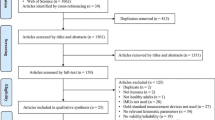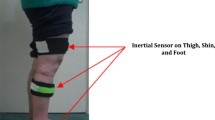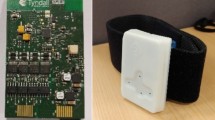Abstract
Background
Analysis of lower limb exercises is traditionally completed with four distinct methods: (1) 3D motion capture; (2) depth-camera-based systems; (3) visual analysis from a qualified exercise professional; and (4) self-assessment. Each method is associated with a number of limitations.
Objective
The aim of this systematic review is to synthesise and evaluate studies which have investigated the capacity for inertial measurement unit (IMU) technologies to assess movement quality in lower limb exercises.
Data Sources
A systematic review of studies identified through the databases of PubMed, ScienceDirect and Scopus was conducted.
Study Eligibility Criteria
Articles written in English and published in the last 10 years which investigated an IMU system for the analysis of repetition-based targeted lower limb exercises were included.
Study Appraisal and Synthesis Methods
The quality of included studies was measured using an adapted version of the STROBE assessment criteria for cross-sectional studies. The studies were categorised into three groupings: exercise detection, movement classification or measurement validation. Each study was then qualitatively summarised.
Results
From the 2452 articles that were identified with the search strategies, 47 papers are included in this review. Twenty-six of the 47 included studies were deemed as being of high quality.
Conclusions
Wearable inertial sensor systems for analysing lower limb exercises is a rapidly growing field of research. Research over the past 10 years has predominantly focused on validating measurements that the systems produce and classifying users’ exercise quality. There have been very few user evaluation studies and no clinical trials in this field to date.

Similar content being viewed by others
References
Waller M, Gersick M, Holman D. Various jump training styles for improvement of vertical jump performance. Strength Cond J. (Lippincott Williams Wilkins) [Internet]. 2013;35:82–9. http://search.ebscohost.com/login.aspx?direct=true&db=s3h&AN=85709355&lang=pt-br&site=ehost-live.
Whittaker JL, Booysen N, de la Motte S, Dennett L, Lewis CL, Wilson D. Predicting sport and occupational lower extremity injury risk through movement quality screening: a systematic review. Br J Sports Med. 2017;51:580–5. https://doi.org/10.1136/bjsports-2016-096760.
Giggins OM, Sweeney KT, Caulfield B. Rehabilitation exercise assessment using inertial sensors: a cross-sectional analytical study. J Neuroeng Rehabil 2014;11:158. http://www.jneuroengrehab.com/content/11/1/158. Accessed 13 May 2017.
Farrokhi S, Pollard CD, Souza RB, Chen Y-J, Reischl S, Powers CM. Trunk position influences the kinematics, kinetics, and muscle activity of the lead lower extremity during the forward lunge exercise. J Orthop Sports Phys Ther. 2008;38:403–9.
Ahmadi A, Mitchell E, Destelle F, Gowing M, O’Connor NE, Richter C. Automatic activity classification and movement assessment during a sports training session using wearable inertial sensors. In: Proc 11th Int Conf Wearable Implant Body Sens Networks, BSN 2014. 2014. p. 98–103.
Bonnechère B, Jansen B, Salvia P, Bouzahouene H, Omelina L, Moiseev F. Validity and reliability of the Kinect within functional assessment activities: comparison with standard stereophotogrammetry. Gait Posture. 2014;39:593–8.
Bonnet V, Mazza C, Fraisse P, Cappozzo A. An optimization algorithm for joint mechanics estimate using inertial measurement unit data during a squat task. Proc Annu Int Conf IEEE Eng Med Biol Soc, EMBS. 2011. p. 3488–91.
Arulampalam J, Pierrepont J, Kark L. Markerless motion capture: validity of microsoft kinect cameras and ipisoft. Gait Posture. 2018;42:S76. https://doi.org/10.1016/j.gaitpost.2015.06.141 (Elsevier).
Whiteside D, Deneweth JM, Pohorence MA, Sandoval B, Russell JR, McLean SG. Grading the functional movement screenTM: A comparison of manual (real-time) and objective methods. [Internet]. J Strength Cond Res. 2014. http://www.ncbi.nlm.nih.gov/pubmed/25162646.
John OP, Robins RW, Craik KH, Dawes RM, Funder DC, Kemis M. Accuracy and bias in self-perception: individual differences in self-enhancement and the role of narcissism. J Pers Soc Psychol. 1994;66:206–19.
Madgwick SOH, Harrison AJL, Vaidyanathan R. Estimation of IMU and MARG orientation using a gradient descent algorithm. IEEE Int Conf Rehabil Robot. 2011.
Burns A, Greene BR, McGrath MJ, O’Shea TJ, Kuris B, Ayer SM. SHIMMERTM–A wireless sensor platform for noninvasive biomedical research. IEEE Sens J. [Internet]. 2010;10:1527–34. http://ieeexplore.ieee.org/lpdocs/epic03/wrapper.htm?arnumber=5482214.
McGrath D, Greene BR, O’Donovan KJ, Caulfield B. Gyroscope-based assessment of temporal gait parameters during treadmill walking and running. Sport Eng. 2012;15:207–13.
Morris D, Saponas TS, Guillory A, Kelner I. RecoFit: using a wearable sensor to find, recognize, and count repetitive exercises. In: CHI ’14 Proc SIGCHI Conf Hum Factors Comput Syst. [Internet]. ACM; 2014. p. 3225–34. http://dl.acm.org/citation.cfm?id=2557116.
Leardini A, Lullini G, Giannini S, Berti L, Ortolani M, Caravaggi P. Validation of the angular measurements of a new inertial-measurement-unit based rehabilitation system: comparison with state-of-the-art gait analysis. J Neuroeng Rehabil. 2014;11:1–7.
Tang Z, Sekine M, Tamura T, Tanaka N, Yoshida M, Chen W. Measurement and estimation of 3D orientation using magnetic and inertial sensors. Adv Biomed Eng. 2015;4:135–43.
Chang K, Chen MY, Canny J. Tracking free-weight exercises. Ubiquitous Comput. 2007. p. 19–37.
Giggins O, Sweeney KT, Caulfield B. The use of inertial sensors for the classification of rehabilitation exercises. In: Conf Proc IEEE Eng Med Biol Soc. 2014;2965–8.
Yurtman A, Barshan B. Automated evaluation of physical therapy exercises using multi-template dynamic time warping on wearable sensor signals. Comput Methods Programs Biomed. [Internet]. 2014;117:189–207. http://www.sciencedirect.com/science/article/pii/S0169260714002910. Accessed 19 May 2017.
Lin JFS, Kulić D. Human pose recovery using wireless inertial measurement units. Physiol Meas. [Internet]. 2012;33:2099–115. http://www.ncbi.nlm.nih.gov/pubmed/23174667.
Gleadhill S, Lee JB, James D. The development and validation of using inertial sensors to monitor postural change in resistance exercise. J Biomech. [Internet]. 2016;49:1259–63. http://www.sciencedirect.com/science/article/pii/S0021929016302937. Accessed 22 May 2017.
Setuain I, González-Izal M, Alfaro J, Gorostiaga E, Izquierdo M. Acceleration and orientation jumping performance differences among elite professional male handball players with or without previous ACL reconstruction: an inertial sensor unit-based study. PM&R [Internet]. 2015;7:1243–53. http://www.sciencedirect.com/science/article/pii/S1934148215002567. Accessed 13 May 2017.
Taylor PE, Almeida GJM, Kanade T, Hodgins JK. Classifying human motion quality for knee osteoarthritis using accelerometers. In: 2010 Annu Int Conf IEEE Eng Med Biol Soc. 2010. p. 339–43.
Patterson M, Caulfield B. A method for monitoring reactive strength index. Proced Eng. 2010;2:3115–20. https://doi.org/10.1016/j.proeng.2010.04.120.
Fong DTP, Chan YY. The use of wearable inertial motion sensors in human lower limb biomechanics studies: a systematic review. Sensors (Switzerland). 2010. p. 11556–65.
Patel S, Park H, Bonato P, Chan L, Rodgers M. A review of wearable sensors and systems with application in rehabilitation. J Neuroeng Rehabil. [Internet]. 2012;9:21. http://www.jneuroengrehab.com/content/9/1/21. Accessed 27 May 2017.
Wang Q, Markopoulos P, Yu B, Chen W, Timmermans A. Interactive wearable systems for upper body rehabilitation: a systematic review. J Neuroeng Rehabil. [Internet]. London: BioMed Central; 2017;14:20. http://www.ncbi.nlm.nih.gov/pmc/articles/PMC5346195/.
Wang Q, Chen W, Markopoulos P. Literature review on wearable systems in upper extremity rehabilitation. Biomed Heal Informatics (BHI), 2014 IEEE-EMBS Int Conf IEEE; 2014. p. 551–5.
Wong WY, Wong MS, Lo KH. Clinical applications of sensors for human posture and movement analysis: a review. Prosthet Orthot Int. 2007;31:62–75. https://doi.org/10.1080/03093640600983949 (SAGE Publications).
Noorkõiv M, Rodgers H, Price CI. Accelerometer measurement of upper extremity movement after stroke: a systematic review of clinical studies. J Neuroeng Rehabil. [Internet]. London: BioMed Central; 2014;11:144. http://www.ncbi.nlm.nih.gov/pmc/articles/PMC4197318/.
Howcroft J, Kofman J, Lemaire ED. Review of fall risk assessment in geriatric populations using inertial sensors. J Neuroeng Rehabil. [Internet]. BioMed Central; 2013;10:91. http://www.ncbi.nlm.nih.gov/pmc/articles/PMC3751184/.
Cuesta-Vargas AI, Galán-Mercant A, Williams JM. The use of inertial sensors system for human motion analysis. Phys Ther Rev. [Internet]. 2010;15:462–73. http://www.ncbi.nlm.nih.gov/pmc/articles/PMC3566464/.
Ribeiro DC, Sole G, Abbott JH, Milosavljevic S. Extrinsic feedback and management of low back pain: a critical review of the literature. Man Ther. 2017;16:231–9. https://doi.org/10.1016/j.math.2010.12.001 (Elsevier).
Subramanian SK, Massie CL, Malcolm MP, Levin MF. Does provision of extrinsic feedback result in improved motor learning in the upper limb poststroke? A systematic review of the evidence. Neurorehabil Neural Repair. 2009;24:113–24. https://doi.org/10.1177/1545968309349941 (SAGE Publications).
Saposnik G, Levin M. Virtual reality in stroke rehabilitation. Stroke [Internet]. 2011;42:1380–6. http://stroke.ahajournals.org/content/42/5/1380.abstract. Accessed 25 May 2017.
Moher D, Liberati A, Tetzlaff J, Altman DG, The PRISMA Group. Preferred reporting items for systematic reviews and meta-analyses: the PRISMA statement. PLoS Med. 2009;6(7):e1000097.
Von Elm E, Altman DG, Egger M, Pocock SJ, Gøtzsche PC, Vandenbroucke JP. The strengthening the reporting of observational studies in epidemiology (STROBE) statement: guidelines for reporting observational studies. J Clin Epidemiol. 2008;61:344–9.
Haladjian J, Hodaie Z, Xu H, Yigin M, Bruegge B, Fink M. KneeHapp: a bandage for rehabilitation of knee injuries. In: Proc 2015 ACM Int Symp Wearable Comput. 2015;181–4.
Bolink SAAN, Naisas H, Senden R, Essers H, Heyligers IC, Meijer K. Validity of an inertial measurement unit to assess pelvic orientation angles during gait, sit–stand transfers and step-up transfers: Comparison with an optoelectronic motion capture system. Med Eng Phys. [Internet]. 2016;38:225–31. http://www.sciencedirect.com/science/article/pii/S1350453315002672. Accessed 13 May 2017.
Faber GS, Chang CC, Kingma I, Dennerlein JT. Lifting style and participant’s sex do not affect optimal inertial sensor location for ambulatory assessment of trunk inclination. J Biomech. 2013;46:1027–30. https://doi.org/10.1016/j.jbiomech.2012.12.007 (Elsevier).
Mehta SP, Barker K, Bowman B, Galloway H, Oliashirazi N, Oliashirazi A. Reliability, concurrent validity, and minimal detectable change for iphone goniometer app in assessing knee range of motion. J Knee Surg. 2016;30:577–84.
Romero Morales C, Calvo Lobo C, Rodríguez Sanz D, Sanz Corbalán I, Ruiz Ruiz B, López López D. The concurrent validity and reliability of the Leg Motion system for measuring ankle dorsiflexion range of motion in older adults. PeerJ [Internet]. San Francisco, USA: PeerJ Inc.; 2017;5:e2820. http://www.ncbi.nlm.nih.gov/pmc/articles/PMC5214953/.
Bonnet V, Mazza C, Fraisse P, Cappozzo A. Real-time estimate of body kinematics during a planar squat task using a single inertial measurement unit. IEEE Trans Biomed Eng IEEE. 2013;60:1920–6.
Quagliarella L, Sasanelli N, Belgiovine G, Moretti L, Moretti B. Evaluation of standing vertical jump by ankles acceleration measurement. J Strength Cond Res LWW. 2010;24:1229–36.
Gordon D, Mullane SL, Conway PP, West AA. Development of a novel system for monitoring strength and conditioning in elite athletes. Proced Eng. [Internet]. 2012;34:496–501. http://www.sciencedirect.com/science/article/pii/S1877705812016980. Accessed 2 June 2017.
Setuain I, Martinikorena J, Gonzalez-Izal M, Martinez-Ramirez A, Gómez M, Alfaro-Adrián J. Vertical jumping biomechanical evaluation through the use of an inertial sensor-based technology. J Sports Sci. 2016;34:843–51. https://doi.org/10.1080/02640414.2015.1075057.
Rawson ES, Walsh TM. Estimation of resistance exercise energy expenditure using accelerometry. Med Sci Sports Exerc. [Internet]. 2010 [cited 2013 Dec 20];42:622–8. http://www.ncbi.nlm.nih.gov/pubmed/19952824.
Papi E, Osei-Kuffour D, Chen Y-MA, McGregor AH. Use of wearable technology for performance assessment: a validation study. Med Eng Phys. [Internet]. Butterworth-Heinemann; 2015;37:698–704. http://www.ncbi.nlm.nih.gov/pmc/articles/PMC4510317/.
Zijlstra W, Bisseling RW, Schlumbohm S, Baldus H. A body-fixed-sensor-based analysis of power during sit-to-stand movements. Gait Posture [Internet]. 2010;31:272–8. http://www.sciencedirect.com/science/article/pii/S0966636209006559. Accessed 23 May 2017.
Charlton PC, Mentiplay BF, Pua YH, Clark RA. Reliability and concurrent validity of a Smartphone, bubble inclinometer and motion analysis system for measurement of hip joint range of motion. J Sci Med Sport Sports Med Aust. 2015;18:262–7. https://doi.org/10.1016/j.jsams.2014.04.008.
Bo APL, Hayashibe M, Poignet P. Joint angle estimation in rehabilitation with inertial sensors and its integration with kinect. Eng Med Biol Soc EMBC. In: 2011 Annu Int Conf IEEE. IEEE; 2011. p. 3479–83.
Pernek I, Hummel KA, Kokol P. Exercise repetition detection for resistance training based on smartphones. Pers Ubiquitous Comput. 2012;17:771–82.
Omkar SN, Vyas K, Vikranth HN. Time-frequency analysis of human motion during rhythmic exercises. Eng Med Biol Soc EMBC, 2011 Ann Int Conf IEEE. IEEE; 2011. p. 1279–82.
Arai T, Obuchi S, Shiba Y, Omuro K, Inaba Y, Kojima M. The validity of an assessment of maximum angular velocity of knee extension (KE) using a gyroscope. Arch Gerontol Geriatr. 2012;54:175–80. https://doi.org/10.1016/j.archger.2011.10.012 (Elsevier).
Chakraborty S, Jamthe A, Ghosh SK, Agrawal DP. Determining athlete’s injury with wireless body area sensor network-based overhead squat testing. Mob Ad-Hoc Sens Syst (MASS), 2013 IEEE 10th Int Conf IEEE; 2013. p. 439–40.
Fitzgerald D, Foody J, Kelly D, Ward T, Markham C, McDonald J. Development of a wearable motion capture suit and virtual reality biofeedback system for the instruction and analysis of sports rehabilitation. Eng Med Biol Soc EMBS. 2007. p. 4870–4.
Ai QS, Chen L, Liu Q, Zou L. Rehabilitation assessment for lower limb disability based on multi-disciplinary approaches. Aust Phys Eng Sci Med. 2014;37:355–65.
Giggins O, Kelly D, Caulfield B. Evaluating rehabilitation exercise performance using a single inertial measurement unit. In: 7th Int Conf Pervasive Comput Technol Healthc Work. [Internet]. 2013 [cited 2014 Nov 13]. p. 49–56. http://eudl.eu/doi/10.4108/pervasivehealth.2013.252061.
Chen K-H, Chen P-C, Liu K-C, Chan C-T. Wearable sensor-based rehabilitation exercise assessment for knee osteoarthritis. Sensors (Basel). [Internet]. Springer; 2015;15:4193–211. http://www.ncbi.nlm.nih.gov/pmc/articles/PMC4367405/.
Houmanfar R, Karg M, Kulić D. Movement analysis of rehabilitation exercises: distance metrics for measuring patient progress. IEEE Syst J IEEE. 2016;10:1014–25.
Chen K-H, Tseng W-C, Liu K-C, Chan C-T. Using gyroscopes and accelerometers as a practical rehabilitation monitor system after total knee arthroplasty. In: 2015 IEEE MTT-S 2015 Int Microw Work Ser RF Wirel Technol Biomed Healthc Appl. IEEE; 2015. p. 58–9.
Streiner DL, Norman GR. Health Measurement Scales: a practical guide to their development and use. 5th ed. Oxford: Oxford University Press; 2008.
Tunçel O, Altun K, Barshan B. Classifying human leg motions with uniaxial piezoelectric gyroscopes. Sensors (Basel). [Internet]. MDPI; 2009;9:8508–46. http://www.ncbi.nlm.nih.gov/pmc/articles/PMC3260598/.
Chen P, Huang C-N, Chen I, Chan C. A rehabilitation exercise assessment system based on wearable sensors for knee osteoarthritis. In: Int Conf Smart Homes Heal Telemat. Springer; 2013. p. 267–72.
Ahmadi A, Mitchell E, Richter C, Destelle F, Gowing M, O’Connor NE. Automatic activity classification and movement assessment during a sports training session using wearable inertial sensors. IEEE Internet Things J. 2015;2:23–32.
Conger SA, Guo J, Fulkerson SM, Pedigo L, Chen H, Bassett DR. Objective assessment of strength training exercises using a wrist-worn accelerometer. Med Sci Sports Exerc. [Internet]. 2016;48:1847–55. http://europepmc.org/abstract/MED/27054678. Accessed 4 June 2017.
O’Reilly M, Whelan D, Ward TE, Delahunt E, Caulfield B. Technology in S&C: Tracking lower limb exercises with wearable sensors. J Strength Cond Res. [Internet]. 2017;pre-print. http://insights.ovid.com/crossref?an=00124278-900000000-96098. Accessed 17 Apr 2017.
Dominguez Veiga JJ, O’Reilly M, Whelan D, Caulfield B, Ward TE. Feature-free activity classification of inertial sensor data with machine vision techniques: Method, development, and evaluation. JMIR Mhealth Uhealth [Internet]. 2017;5:e115. http://mhealth.jmir.org/2017/8/e115/. Accessed 19 Aug 2017.
Kianifar R, Lee A, Raina S, Kulić D. Classification of squat quality with inertial measurement units in the single leg squat mobility test. In: 38th Annu Int Conf IEEE Eng Med Biol Soc. 2016. p. 6273–6.
Whelan DF, O’Reilly MA, Ward TE, Delahunt E, Caulfield B. Technology in rehabilitation: Evaluating the single leg squat exercise with wearable inertial measurement units. Methods Inf Med. [Internet]. Schattauer Publishers; 2016;55:[Epub ahead of print]. http://dx.doi.org/10.3414/ME16-02-0002.
O’Reilly MA, Whelan DF, Ward TE, Delahunt E, Caulfield B. Classification of lunge biomechanics with multiple and individual inertial measurement units. Sport Biomech. 2017;16:342–60.
O’Reilly MA, Whelan DF, Ward TE, Delahunt E, Caulfield BM. Technology in S&C: Assessing bodyweight squat technique with wearable sensors. J Strength Cond Res. 2017.
O’Reilly MA, Whelan DF, Ward TE, Delahunt E, Caulfield B. Technology in rehabilitation: comparing personalised and global classification methodologies in evaluating the squat exercise with wearable imus. Methods Inf Med. 2017;56:1–9.
O’Reilly MA, Whelan DF, Ward TE, Delahunt E, Caulfield BM. Classification of deadlift biomechanics with wearable inertial measurement units. J Biomech. 2017;58:155–61.
O’Reilly M, Duffin J, Ward T, Caulfield B. Mobile app to streamline the development of wearable sensor-based exercise biofeedback systems: system development and evaluation. JMIR Rehabil Assist Technol [Internet]. 2017;4:e9. http://rehab.jmir.org/2017/2/e9/. Accessed 13 Sept 2017.
Kotsiantis SB. Supervised machine learning: a review of classification techniques. Informatica [Internet]. 2007. http://books.google.com/books?hl=en&lr=&id=vLiTXDHr_sYC&oi=fnd&pg=PA3&dq=survey+machine+learning&ots=CVsyuwYHjo&sig=A6wYWvywU8XTc7Dzp8ZdKJaW7rc%5Cnpapers://5e3e5e59-48a2-47c1-b6b1-a778137d3ec1/Paper/p800%5Cnhttp://www.informatica.si/PDF/31-3/11_Kotsiantis. Accessed 7 July 2017.
Zeng M, Nguyen LT, Yu B, Mengshoel OJ, Zhu J, Wu P. Convolutional neural networks for human activity recognition using mobile sensors. In: Pro 6th Int Conf Mob Comput Appl Serv. [Internet]. 2014. p. 197–205. https://www.computer.org/csdl/proceedings/mobicase/2014/024/00/07026300-abs.html. Accessed 15 June 2017.
Jia Y, Shelhamer E, Donahue J, Karayev S, Long J, Girshick R. Caffe: convolutional architecture for fast feature embedding. ACM Int Conf Multimed. 2014;675–8.
Whelan DF, O’Reilly MA, Huang B, Giggins OM, Kechadi T, Caulfield B. Leveraging IMU data for accurate exercise performance classification and musculoskeletal injury risk screening. In: 38th Annu Int Conf IEEE Eng Med Biol Soc 2016 [Internet]. IEEE; 2016. p. 1–6. http://dx.doi.org/10.3414/ME16-02-0002.
Breiman L. Random forests. Mach Learn. 2001;45:5–32. https://doi.org/10.1023/A:1010933404324.
Hearst MA, Dumais ST, Osman E, Platt J, Scholkopf B. Support vector machines. IEEE Intell Syst. 1998;13:18–28.
Dudani SA. The distance-weighted k-nearest-neighbor rule. IEEE Trans Syst Man Cybern. 1976;6:325–7.
Author information
Authors and Affiliations
Corresponding author
Ethics declarations
Funding
Martin O’Reilly was partially funded for this work by the Irish Research Council as part of a Postgraduate Enterprise Partnership Scheme with Shimmer (EPSPG/2013/574). Brian Caulfield, Tomas Ward, William Johnston and Cailbhe Doherty were funded and Martin O’Reilly was partially funded by Science Foundation Ireland under their grant for the Insight Centre for Data Analytics (SFI/12/RC/2289). These funding bodies had no influence on the data collection, data analysis, data interpretation or approval/disapproval of publication.
Conflict of interest
Martin O’Reilly, Brian Caulfield, Tomas Ward, William Johnston and Cailbhe Doherty declare that they have no conflicts of interest relevant to the content of this review.
Rights and permissions
About this article
Cite this article
O’Reilly, M., Caulfield, B., Ward, T. et al. Wearable Inertial Sensor Systems for Lower Limb Exercise Detection and Evaluation: A Systematic Review. Sports Med 48, 1221–1246 (2018). https://doi.org/10.1007/s40279-018-0878-4
Published:
Issue Date:
DOI: https://doi.org/10.1007/s40279-018-0878-4




